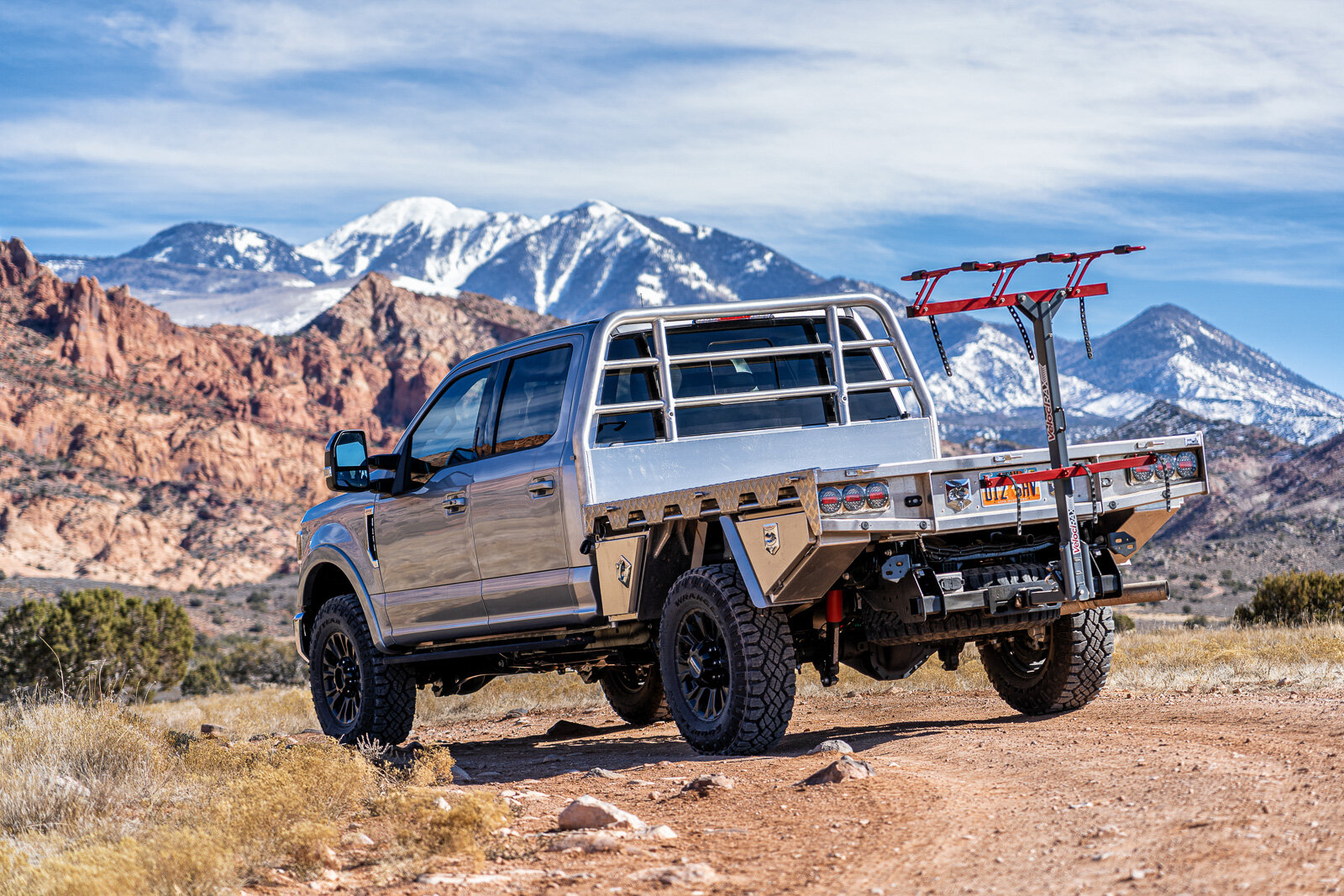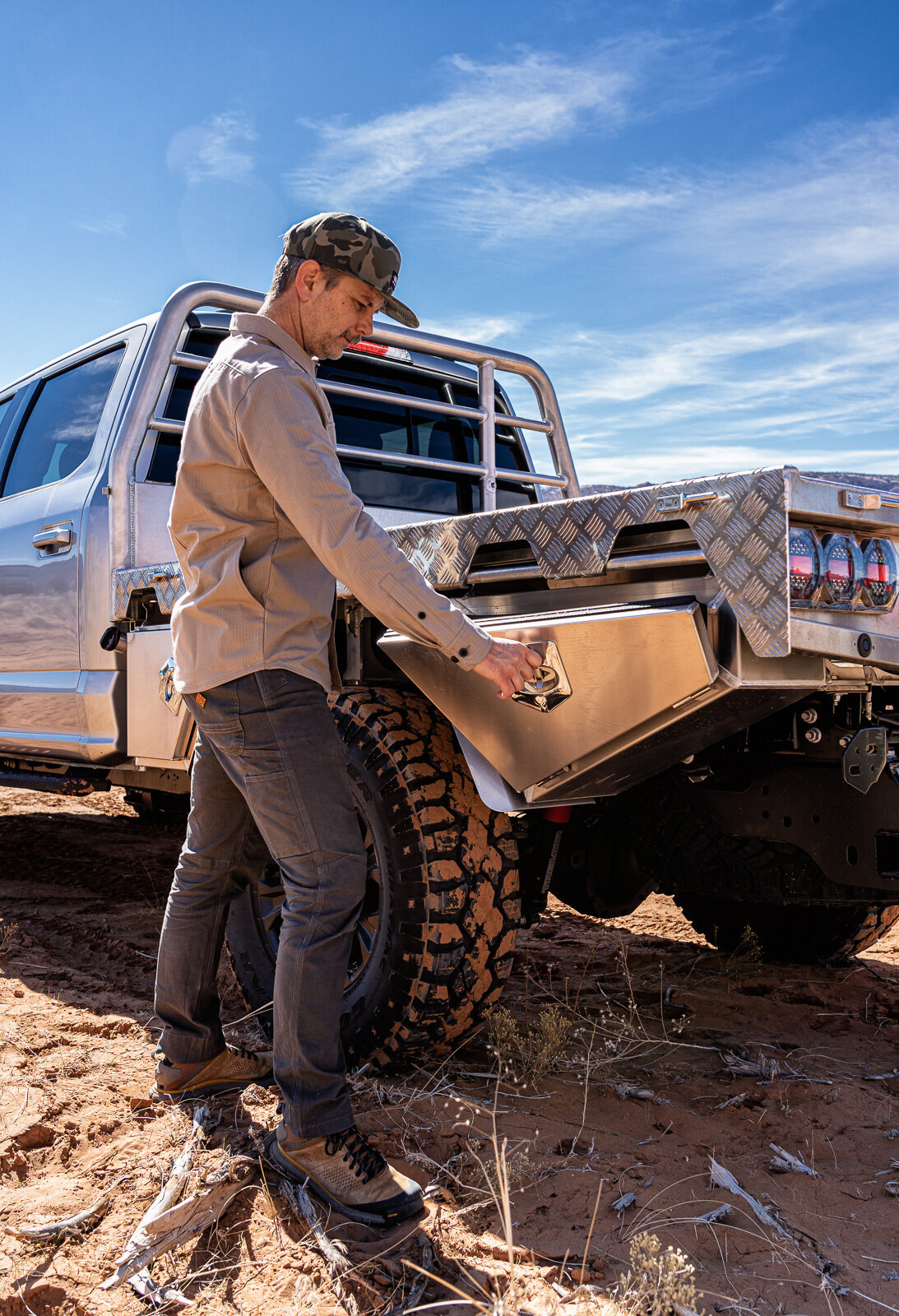As outdoor photographers, we spend more time alone in remote backcountry locations than the average Joe. We are always on the hunt for that next epic photo and sometimes we let the thrill of the chase override common sense. Usually, we have lady luck on our side but every once in a while, things do go south. Are you prepared to self-rescue when it does?
In this article I’ll present a few tips you can use to maximize personal safety during offroad or overland vehicle travel. In future articles I’ll cover other important topics related to staying safe while making images in the great outdoors.
All-Wheel Drive vs. Four Wheel Drive
First and foremost, let’s get something important out of the way. All-wheel drive (AWD) and four-wheel drive (4WD) are not the same thing. Most AWD vehicles can safely navigate forest roads and some can perform on mildly technical terrain, but they are not designed for the rough conditions encountered on a true 4WD trail. What is an AWD vehicle? Think Subaru. Moving now to 4WD vehicles, some – but not all – generally have more ground clearance, stronger frames, better suspension and a transfer case with high and low gearing. Examples of true 4WD’s are the Toyota Tacoma and 4Runner, Ford Bronco and the venerable Jeep Wrangler. Knowing the difference between AWD and 4WD – and being able to identify the limitations and capabilities of your own vehicle – is critically important to your safety. If you really want to geek out on the differences between AWD and 4WD, Expedition Portal recently published an excellent article that delves deep into this topic.
Haystack Rock dominates the horizon behind an overlanding camper on McPhillips Beach near Pacific City, Oregon.
Maximize Safety with These Two Important Factors
Now that you have a basic understanding of AWD vs. 4WD, let’s talk about what might be the two most important factors that contribute to the safety of your offroad vehicle adventures; judgment and skill. Not getting yourself into trouble in the first place is the single best way to guarantee your safety. Trust me, I get it. The conditions are all lining up for what promises to be an epic sunset, and that spectacular canyon view you read about is just a couple miles down the benign looking dirt road in front of you. “Eh, I’m sure it’ll be fine. Let’s do this!” And then, you’re off. The dirt road begins to deteriorate, but you press on, and soon you’re high centered on a boulder…or worse. Knowing when it’s time to admit defeat and turn around, i.e. using good judgment, will save your bacon almost every time. Almost. At this point I need to emphasize that Mother Nature is always in control. We can and should do everything possible to prepare for and respond to the worst but in the end, sometimes our best just isn’t good enough.
Next up, skill. Unfortunately, when you buy a Jeep the skill to safely and confidently drive it offroad isn’t an included feature. Driving offroad on even moderately technical trails places unique demands on a driver and having a capable rig without the skill to drive it is a recipe for disaster. One of the best ways to get up to speed fast is to take an offroad driving course with a qualified instructor. The Offroad Safety Academy and Barlow Adventures are two of the best in the business. After that, you’ll enhance your skillset every time you turn off the pavement by applying the knowledge you learned in real world situations.
Have a Plan, Share the Plan, Stick to the Plan
Before you wander off into the great unknown, tell someone where you’re going and when you expect to be home. Better yet, write it down or text it to a trusted friend or family member. Then, stick to the plan. Don’t deviate. When you squirrel and get stranded or injured somewhere that wasn’t part of your plan, and your friend or family member notifies the authorities because you never made it home, you’re making the SAR team’s job much more difficult. In a grave situation, it could be the difference between life and death. Stick to the plan.
Prepare for Self-Rescue, Be Ready for Self-Sufficiency
What do you carry when you’re headed off-pavement? There are a few things that are mandatory, and a couple that are nice to have. Let’s explore the mandatory items first.
Ideally, your spare tire should be the same size as the other four, properly inflated, and it should be in good condition. A donut tire does not count, but a regular offroad tire – even one smaller than the other four – will usually get you home safe. Along with the spare tire, you’ll need a jack and all the tools you need to change a flat. This includes a lug nut key, if you’re using anti-theft lug nuts. You should also know how to change a flat tire in off-road conditions because there are unique challenges. 4 Wheel Parts covers this in depth in their article, “How To Change a Flat Tire Off-Road”. For those of us running large tires, which can weigh over 100 pounds, Nena Barlow filmed a terrific video demonstrating how to handle heavy tires without making your chiropractor rich(er).
Carry a small tool kit – or at least a multi-tool – with zip ties and duct tape. You’d be surprised how many pickles you can get yourself out of with a bit of ingenuity and a few very basic supplies. I’ve seen friends use bailing wire to repair catastrophic vehicle damage that otherwise would have left them stranded.
Top off your gas tank before you leave civilization and if possible, carry extra fuel – especially if the location you’re visiting is especially remote. I carry two 3 gallon Rotopax fuel cans on the back of my rig. They’re usually empty, but when I know I’ll be somewhere far away from fueling stations, I fill them up. There are myriad ways to mount these to the outside of your vehicle, which is where they belong. Never carry extra fuel inside your vehicle.
I can’t overstate the importance of carrying potable water. My current rig has two large built-in tanks but in the past, I carried a 5 gallon water jug. You don’t have to spend a lot of money on a good, leak-proof jug. I’ve always had good luck with Reliance rigid containers and GSI collapsible water jugs. Before that, when I was much younger and financially limited, I just carried a couple one gallon jugs of water. It’s also a good idea to carry a water filter that allows you to use any water source you can find to create potable water. I carry two Lifestraws in my rig and keep one in my hiking backpack.
You can get by without a first aid kit, but you need a trauma kit. You’ll live if you can’t put a bandage on your ouchy, but survival odds are not in your favor if you can’t tourniquet an arterial bleed or prevent a large open wound from bleeding out. I carry a CAT tourniquet in my rig and backpack – and have seen multiple lives saved by them during my years in law enforcement. I also carry a QuikClot bandage for serious wounds where a tourniquet won’t work. Learn how to use them and practice applying the tourniquet on yourself until it’s second nature. Don’t forget to pack any mandatory medications that you may need.
For better or worse, outdoor photographers spend a lot of time outside, alone. Jumper cables are useless in this scenario. Carry a portable jump pack and be sure to keep it charged. I carry the NOCO Boost XL GB50 in my overland camper, which we had to use recently while camped in the Cascade Mountains of Oregon. The NOCO Boost GB40 lives in our Land Cruiser and 4Runner. Both NOCO models hold a charge for one year and provide multiple jump starts on a single charge.
When you get stuck (not if, but when) you’ll need a way to get unstuck. For solo recoveries, it’s hard to beat a winch – assuming you know how to use one safely – but a set of Maxtrax recovery boards can also be invaluable. I carry them on the back of our truck and have used them multiple times – luckily only to help other drivers free their vehicles. They are very easy to use but I’d still recommend watching this short video for some tips. I also carry a recovery strap but am switching to All-Top kinetic recovery rope. Like a winch, using these can be dangerous and you should familiarize yourself with proper technique. Here’s an article and a video that are both worth reading/watching for valuable insight into using these products safely and effectively. Even better, take a vehicle recovery course!
If cold temperatures are possible, a warm sleeping bag or at least a camping blanket are essential. I carry a Voited Cloudtouch blanket in all of my vehicles, which can be used as a soft, fleecy blanket or you can stuff it into a built-in pocket to create a pillow. There is no reason every vehicle you own shouldn’t have a cheap emergency blanket in the glovebox. On an early 90’s backpacking trip in the Grand Canyon, my friend and I were caught in a spring thunderstorm that saw a precipitous dip in temperatures. Woefully unprepared, we hid out in a small alcove and wrapped ourselves with our emergency blankets. They kept us mostly dry and warm enough to avoid hypothermia.
The batteries don’t die on a map, and thick tree cover doesn’t render them useless because they can’t view satellites. While a GPS can be a useful tool - if you know how to use one - a map is equally valuable. Regardless of whether you use GPS or not, having a good old fashioned paper map can be the difference between being lost and knowing exactly where you are.
You do not want to be caught with your pants down, and without toilet paper. You never know when nature is going to call and you don’t want to resort to leaves or smooth rocks to perform clean-up duty. Carry TP, a small shovel and dog poop bags. When you’ve gotta go, dig a hole at least 6” deep and at least 200’ from any water source, and then cop a squat over the hole to do your business. After wiping, place the used TP in the dog poop bag, tie it off with a knot, and carry it out with you. Do not bury it. DO NOT BURN IT. Should your interest be piqued and you’d like to learn everything there is to know about pooping outside, read REI’s article “How to Go to the Bathroom in the Woods”.
Now, let’s take a look at optional but nice to have items.
Newer iPhones have the ability to send an SOS signal via satellite and if the rumors are true, the next iPhone will also allow you to send text messages and perhaps even make phone calls. Alternatively, something like the Garmin InReach satellite communicator allows you to notify authorities when things have gone so far south that you need emergency assistance. The iPhone is good, but the Garmin is even better.
You can survive for several days without food, but it won’t be comfortable. Packing some high calorie, stable snacks may be just enough to stave off the hangry and help you maintain a positive mindset. I always bring a hearty trail mix, granola bars, and jerky or beef sticks. For extra credit, pack a small backpacking stove and some dehydrated meals or MRE’s. My favorite backpacking stove is the JetBoil, and of all the various dehydrated meal brands, Peak Refuel has been my go-to for several years.
You could have all of these things rolling around your car but it would be unsafe and, at least to me, annoying. I carry everything that will fit in a Radius Outfitters Gearbox 5500. You don’t need to spend $300 on a storage box, though. A plastic tote from your local dollar store is a great budget option or for something a little more durable, Rubbermaid Action Packers have been serving dutifully in this capacity for as long as I can remember.
A small fire can be useful as a signal or for warmth. Obviously, you’ll need a lighter or waterproof matches to get the fire going, but it’s even easier if you have a fire starter – especially if the wood you’re using is damp. Also, this is where common sense is critically important. If the conditions are such that you wouldn’t build a campfire, i.e. extremely dry, windy, building a signal fire is a terrible idea.
More times than I can count, I’ve been driving down a remote dirt road or 4WD trail and found a tree blocking my path. I know several serious overlanders who carry chainsaws. If I had the room, I would too. For now, I carry an axe and a 10” folding saw, and have used both to cut up fallen trees. I’ve also used my recovery strap around the cut logs, connected to my truck, to pull them out of the way.
Don’t Be a Jackass – Tread Lightly
Do you enjoy being able to access those stunning backcountry locations by vehicle? Do you want to maintain that access? Then please, don’t be a jackass. Most of us who have spent enough time offroad in the backcountry have seen “that guy”. The one who passes others by blazing through the tundra, or who parks their rig in a protected area so they can get a photo for Insta, or who just can’t help but high mark a desert badland. These people are part of the reason access is getting cut off to popular spots all over the West. How can you avoid being a jackass? Abide by the Tread Lightly principles. It’s that simple.
So, there you have it. Heed these tips and go forth into the great unknown with the confidence to know that you’re prepared for (almost) whatever comes your way. This is not an exhaustive list, nor will everyone agree with my recommendations. If you feel I’ve left something out, drop it in the comments! We can all share ideas and learn from one another. Just know that if you leave a comment that isn’t constructive, I’ll delete it. Stay safe out there, everyone!
Note: Some links in this article are affiliate links, which means if you click on it and make a purchase, I may receive a small commission at no additional cost to you. Like, small. Really small. But if enough of them add up, I could buy an iced tea (with extra ice), or some dark chocolate, or when I save up for a few months, I could probably even get an SD card. I never recommend products I don’t use and believe in, or that I haven’t vetted to be consistent with my high standards.


















